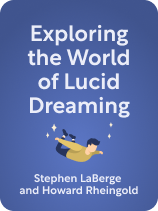

This article is an excerpt from the Shortform book guide to "Exploring the World of Lucid Dreaming" by Stephen LaBerge and Howard Rheingold. Shortform has the world's best summaries and analyses of books you should be reading.
Like this article? Sign up for a free trial here.
What exactly is lucid dreaming? What’s the difference between normal dreams and lucid dreams? Are there any benefits to learning how to lucid dream?
Through lucid dreaming, the ordinary boundaries of reality dissolve, opening up a realm where you can indulge your fantasies, enhance your mental flexibility, learn new skills, and more. A lucid dream differs from a normal dream in that you realize you’re dreaming and can influence the dream.
Here’s a more in-depth overview of what lucid dreaming is.
What Are Lucid Dreams?
In Exploring the World of Lucid Dreaming, Dr. Stephen LaBerge and Howard Rheingold show you how to purposefully “wake up” in your dreams—while still remaining asleep—and explain how such lucid dreaming can change your life. They argue that lucid dreaming can be a powerful tool for positive transformation and explore many gifts that lucid dreams can offer you, including the opportunity to indulge your fantasies, increase your mental flexibility, learn new skills and improve performance, overcome fears, solve problems creatively, and connect to your spirituality.
But, what exactly is lucid dreaming? LaBerge and Rheingold explain that when we dream, we usually watch or participate in the experience without realizing we’re dreaming. Because we don’t know we’re in a dream, it unfolds much like we experience waking life—things happen around us and we respond to them.
In a lucid dream, however, you realize you’re dreaming, and you can consciously influence the dream and change any aspect of it. This can open up a universe of experiences: Instead of being limited by the real world, in a lucid dream you’re limited only by your imagination.
(Shortform note: According to some neuroscientists, the main difference between lucid dreams and regular dreams is our level of introspection—our ability to wonder, question, and reflect on what we’re perceiving in a dream. In typical dreams, we normally have little to no ability to introspect and, therefore, aren’t consciously aware that we’re dreaming. However, lucid dream techniques like LaBerge and Rheingold’s are designed to cultivate your introspective abilities in dreams, which allows you to experience conscious awareness and to control the narrative of your dream.)
Some people have lucid dreams without intending to, but the authors explain that lucid dreaming is also something you can train yourself to do. They argue that it’s easy—you only need to learn how to recognize that you’re in a dream. They caution, however, that although it’s generally safe and enjoyable for many, lucid dreaming may not be safe for everyone, especially people who struggle to distinguish between their waking reality and their imagination. If you find it overwhelming or distressing as you explore lucid dreaming techniques, lucid dreaming may not be right for you.
(Shortform note: Some research indicates that about half the population has experienced a spontaneous lucid dream at least once in their lives. Around 11% reported having frequent lucid dreams—about one or two per month. However, as the authors caution, experts warn that lucid dreaming can pose a risk to some people. This includes those with certain mental health conditions like schizophrenia, as it can exacerbate symptoms of psychosis like delusions and paranoia.)

———End of Preview———
Like what you just read? Read the rest of the world's best book summary and analysis of Stephen LaBerge and Howard Rheingold's "Exploring the World of Lucid Dreaming" at Shortform.
Here's what you'll find in our full Exploring the World of Lucid Dreaming summary:
- Ways to prepare for lucid dreaming
- How to purposefully “wake up” in your dreams
- The many ways lucid dreaming can improve your waking life






